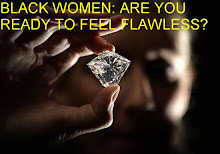HERE'S an excellent
blog post for you to consider. Regarding these sorts of media issues, do you
know what the underlying problem is? As far as I’m concerned, the underlying
problem is that African-American (AA) women consume way too much media.
The vast majority
of us watch FAR too much TV, we listen to too much radio, we spend too much
time online. In short, like AA males, the vast majority of AA women are too
plugged-in. And not cultivating their virtues, talents or charms.Unlike the typical AA female zombie consumer who eagerly laps up anything at all that features Black-skinned faces—even when it’s something degrading—the Sojourners:
- Don’t watch reality TV, Tyler Perry movies, Lee Daniels’ movies, Steve Harvey-related media, Rev. TD Jakes-related media,
- Have no idea what folks are talking about at negro-slave-oriented gossip blogs.
- Have no idea what most negro slave celebrities are up to (because these are generally nonproductive people who aren’t doing anything worth knowing about).
- Have no idea who the latest (c)rappers are or what they’re doing.
The Sojourners have
more common sense than to waste their time with such mess. Sojourners know that
the traditional opening strategy for many upstart, minimal-quality cable TV networks
is to pimp the AA consumer zombies. These networks use cheap, low-quality
Black-oriented programming to build an initial audience of faithful AA consumer
zombies.
After establishing
a stable base audience of AA consumer zombie-viewers, the cable network uses the
financial base created by AA slave viewers to develop more expensive
programming designed to appeal to their true target audience: White viewers.
Once the new network develops a stable of programs favored by a sizeable audience of White
viewers, the network then discards the AA consumer zombies and the
Black-oriented shows used to attract AA consumer zombies. The network throws the slaves away like yesterday's trash. Two good examples of
this strategy are the WB Television Network and UPN. From the Wikipedia entry about the WB Television Network (emphasis in bold):
The network's first programs were mostly sitcoms targeted at an ethnically black audience, though several series during the network's first five years were also targeted at families.
Even though four of the five shows that debuted in the netlet's first nine months – The Wayans Bros., Unhappily Ever After, The Parent 'Hood and Sister, Sister (the latter of which was picked up by the network after being cancelled by ABC) – were renewed beyond the first year, none of them made a significant impact. The WB expanded its programming on Sunday nights for the 1995–1996 season, but none of the new shows (including the Kirk Cameron vehicle Kirk and night-time soap opera Savannah) managed to garner much viewing interest.
From the Wikipedia
entry about UPN (emphasis in bold):
Other notable UPN programs during the network's existence included The Sentinel, Moesha, Star Trek: Enterprise, WWE SmackDown, America's Next Top Model, Girlfriends, the Moesha spin-off The Parkers, Veronica Mars and Everybody Hates Chris. In the summer of 2005, UPN aired R U the Girl, in which R&B group TLC searched for a woman to join them on a new song. The network also produced some special programs, including 2001's Iron Chef USA. From 1996 to 2006, much of UPN's comedy programming for the remainder of the network's run (particularly those seen on the network's Monday evening lineup) was largely aimed at African-American audiences (with minor exceptions in shows such as Clueless, DiResta and Head Over Heels).
Like I said, the Sojourners know better than to
watch the type of mess that the typical AA consumer zombie is watching. But one
lingering issue I’ve noticed even among the Sojourners is that many of us are
still consuming too much media. At the end of the day, media consumption is a
passive activity. It’s the inferior experience of watching somebody else play
tennis as opposed to playing tennis yourself.
The greater rewards in life come from spending less
time in passive activities, and more time actively living life.




